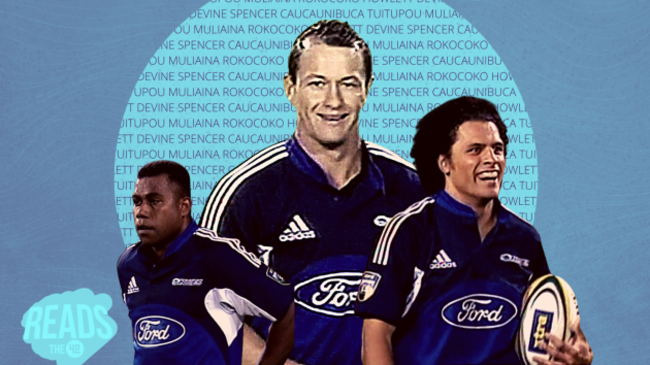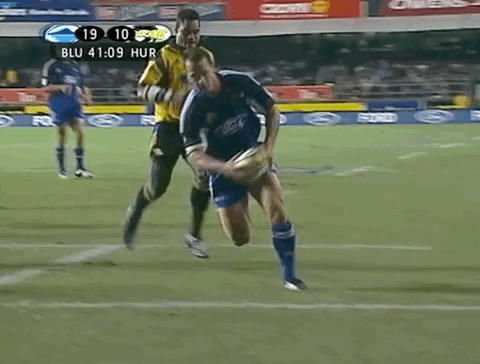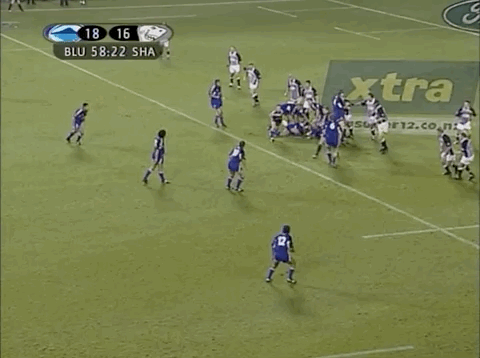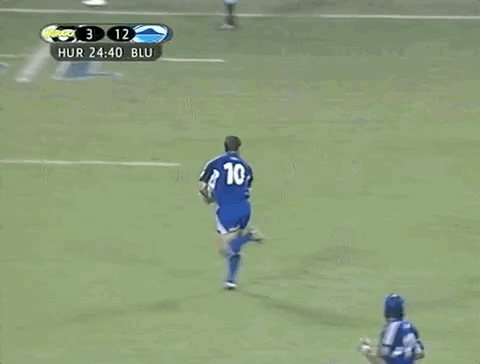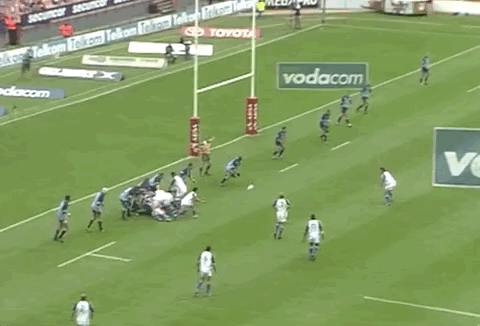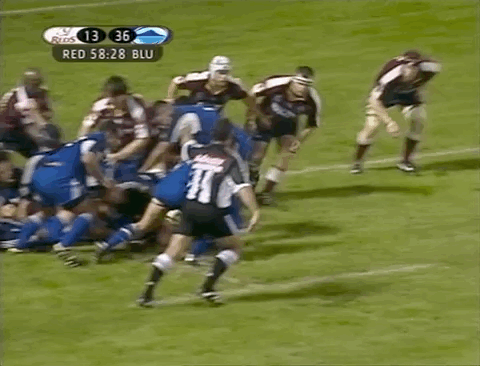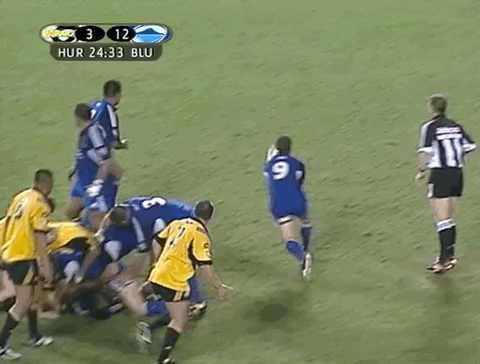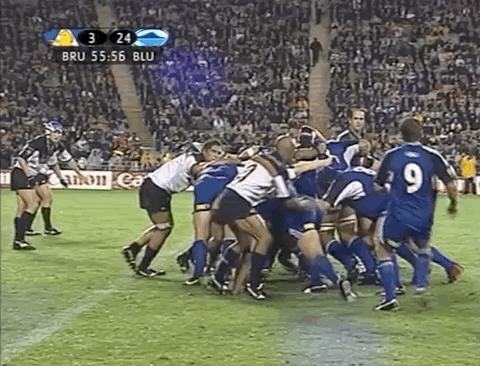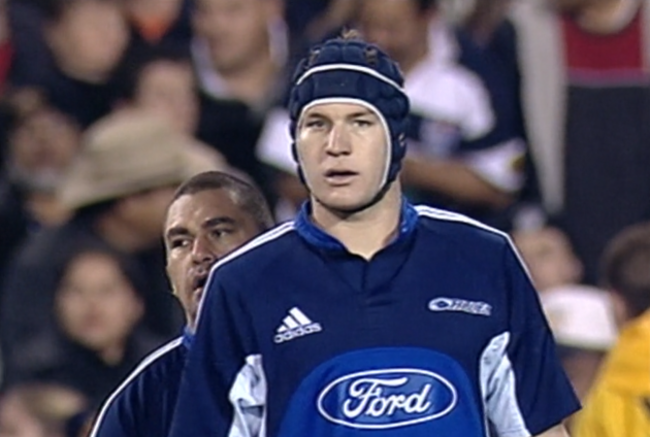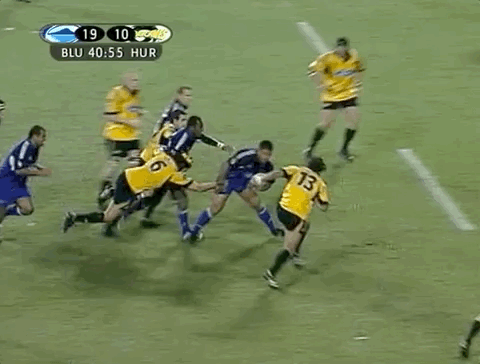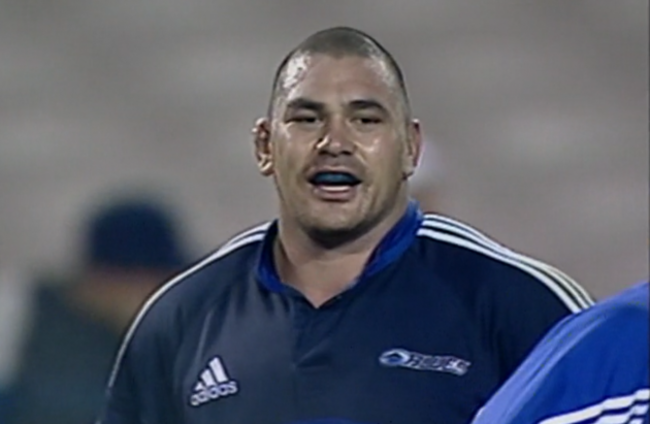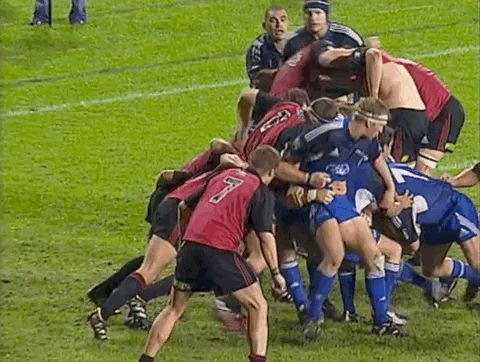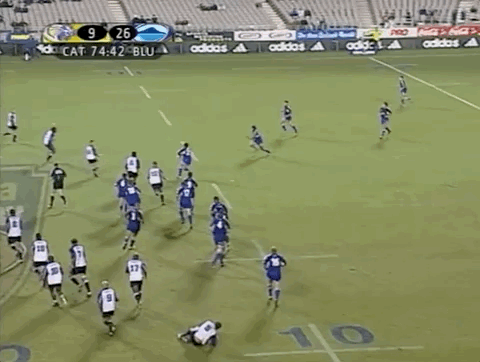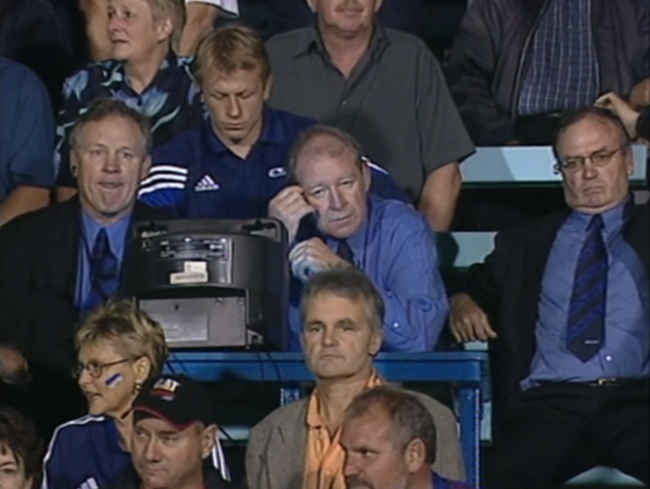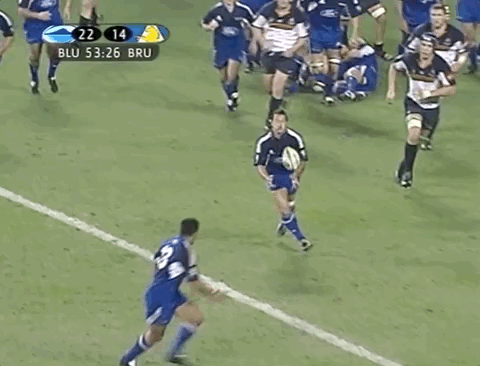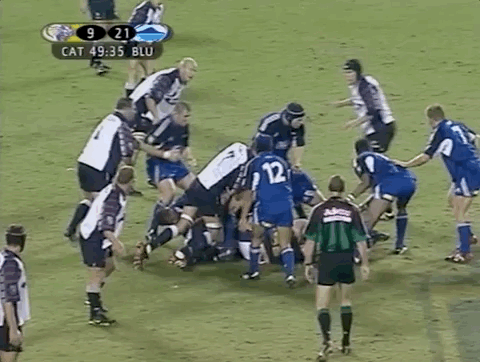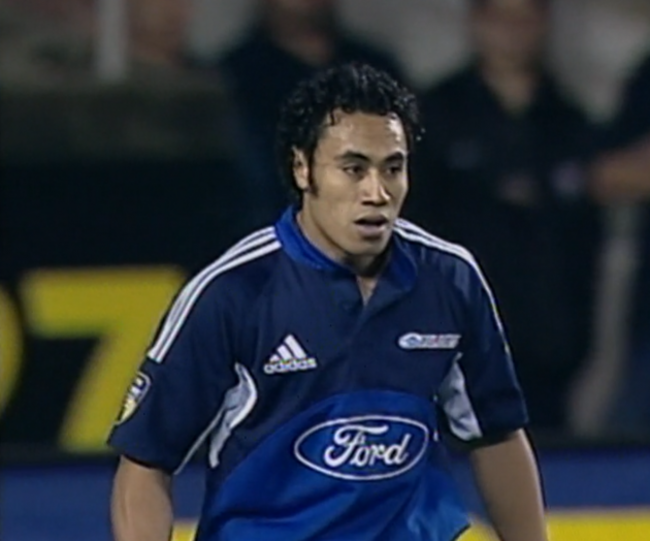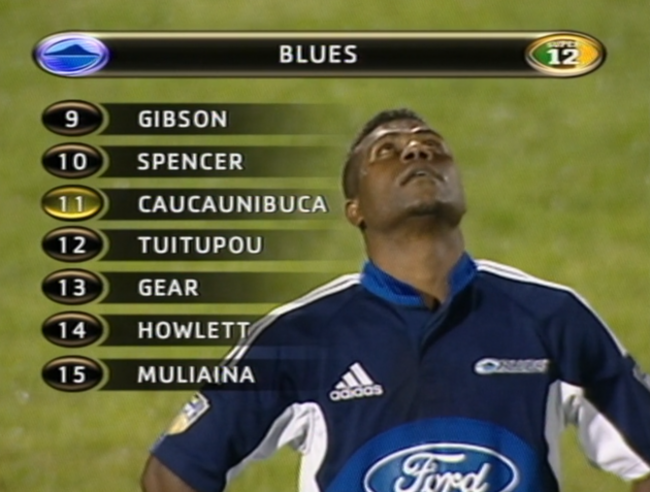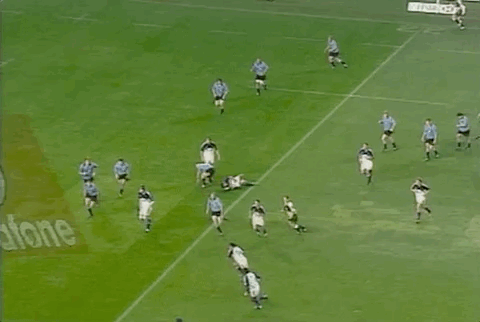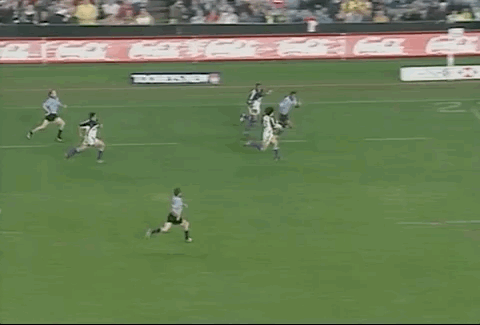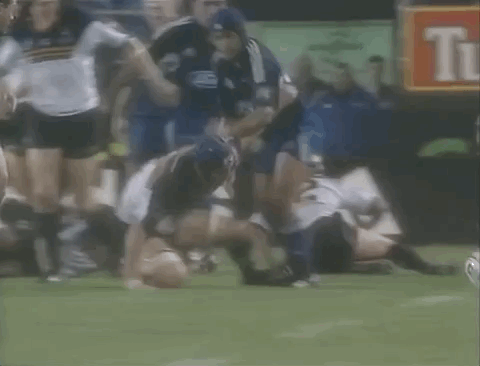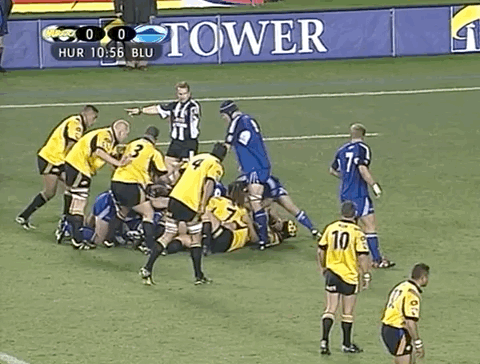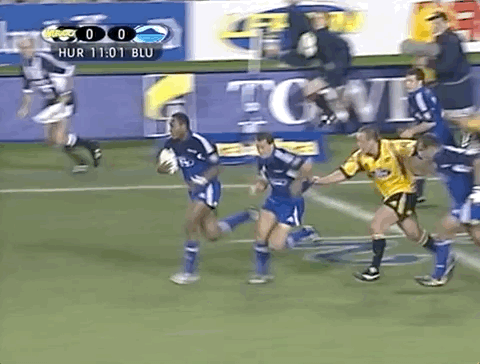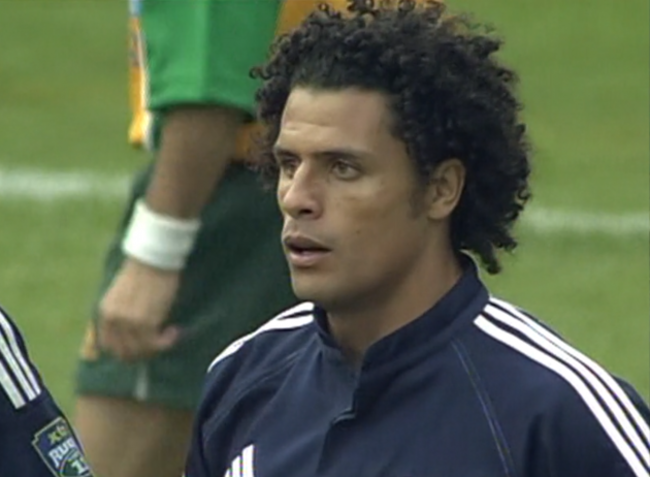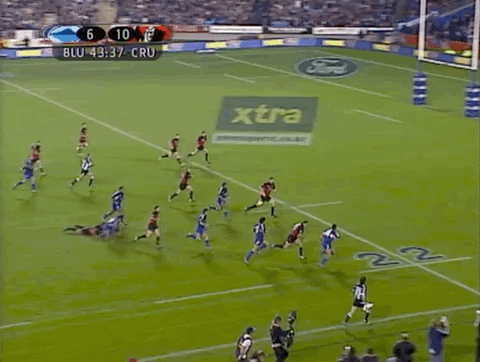PLAYING THE BLUES in 2003 was akin to a nightmare for many of the other Super 12 teams.
The threats were simply everywhere.
Focus too much on Carlos Spencer’s mercurial talents and suddenly Rico Gear or Sam Tuitupou would be picking a brilliant line off the out-half for a break.
Worry too much about Joe Rokocoko out wide and Rupeni Caucaunibuca would be soaring away down the other side, with Doug Howlett or Mils Muliaina running support lines to accept an offload.
Obsess over the Blues backline and the skillful, dynamic pack featuring the likes of Keven Mealamu, Ali Williams, and captain Xavier Rush would be playing through your defence or right over the top of you with a powerful maul.
The 2003 Blues team was the most exciting club side of the professional era so far, scorching their way through Super Rugby for a thrilling trophy success.
- For more great storytelling and analysis from our award-winning journalists, join the club at The42 Membership today. Click here to find out more >
The Auckland franchise had won the first first-ever Super 12 crown in 1996 and retained their title a year later under Graham Henry, but had fallen on tough times by the turn of the century.
They finished 11th in 2001, winning just four games, leading to Peter Sloane joining as head coach. They steadied the ship with a sixth-place finish the following year
In 2003, the Blues lit the fireworks.
King Carlos
‘King Carlos’ was at the heart of this Blues team. Spencer had been the starting out-half for the Blues’ Super 12 wins as a youngster back in ’96 and ’97 and lived through the frustration of underachievement that followed.
But in 2003, Spencer took his game to a thrilling new level as part of the sublimely talented Blues side, helping to nail down his place as the All Blacks’ starting out-half at the 2003 World Cup.
The 27-year-old’s daring, creative play was central to the Blues’ success. He had the full bag of tricks.
There were no-look passes…
There were outrageously exaggerated dummies…
There was his characteristic release and regathering of the ball…
Spencer was also a huge running threat himself thanks to his pace.
In the example below, Spencer dummies a switch pass, then runs a loop – a common theme in the Blues’ game – around Gear to score against the Reds.
Spencer enjoyed launching intricate plays in midfield to create confusion for defences.
The Blues use a double switch in the example below against the Bulls, leading to a try in the right corner for Howlett.
Spencer’s kicking game was a major strength too. He was capable of playing for territory and finding space in the backfield with his vision, while his place-kicking was important at times in 2003.
Spencer’s sheer creativity and skill shone through in his area of the game too.
One of his specialities in this Blues team were disguised banana kicks like the one below, which allowed Howlett to score his 100th first-class try.
It was a play the Blues attempted on several occasions throughout the 2003 season but this example in a sensational performance against the Hurricanes was the standout.
Spencer’s kicking armoury included grubbers too.
The sheer variety of Spencer’s attacking skillset made him irrepressible at times, with the man from the little town of Levin always searching for a solution to unlock the defence.
The out-half was, of course, capable of making big errors. A knock-on in his own 22 in the final against the Crusaders allowed Mark Hammett to score a soft try, but Spencer made magic more often than mistakes.
He thrived because of the players around him. There were superstars aplenty outside Spencer in the backline but the Blues pack was formidable too.
Rush and co.
Xavier Rush never became a key man for the All Blacks, winning eight caps in total, but the number eight was a totem for the Blues and an experienced figure by the time 2003 rolled around.
The skipper was an impactful presence at the back of the scrum, providing power and an excellent skillset – much like the rest of the Blues pack.
Rush, whose try against the Brumbies we see above, was in the middle of a back row that also included the durable, defensively excellent blindside flanker Justin Collins, who started all 13 games of the Blues’ season.
Bringing it all together was openside Daniel Braid, another man who couldn’t quite nail down an All Blacks spot but won six caps.
Braid was highly effective on both sides of the ball, with his breakdown skills often providing the Blues with the turnovers that they were lethal at converting into tries.
In the second row, 22-year-old Ali Williams was a key figure in his second season of Super 12.
He had made his All Blacks debut in 2002 and provided a gritty edge as well as set-piece skills and good handling.
With All Black-capped Troy Flavell ruled out through injury early on, imposing 21-year-old Brad Mika was Williams’ locking partner for most of the season but was replaced by 22-year-old Angus Macdonald – primarily a back row up until then – in the latter stages of the campaign.
24-year-old Keven Mealamu was a vital influence at hooker, with his accurate throwing allowing the Blues to use their lineout as a key attacking platform, while his skills around the pitch were eye-catching too, as below when he offloaded to prop Deacon Manu.
Derren Whitcombe, who went on to win five All Blacks caps, was a very able deputy for Mealamu at hooker.
Manu had injury issues during the season but was the starting loosehead for the business end of the campaign, taking over from the 22-year-old Tony Woodcock, who would go on to become a great All Black.
The relative veteran of the pack was tighthead Kees Meeuws, whose All Blacks debut had come in 1998.
The 28-year-old scored three tries along the way as he featured in all 13 of the Blues’ games in 2003.
While it was a young Blues pack, they formed a cohesive unit. The backline stars grabbed most of the headlines, but it would be remiss not to underline the forwards’ role, including a maul try in the final against the Crusaders, the defending champions.
Braid dotted down at the back of this powerful effort in the second half of the Blues’ 21-17 victory over a Crusaders side including Richie McCaw, Dan Carter, Scott Robertson, Brad Thorn, Justin Marshall, and Aaron Mauger.
The Blues pack also pulled out some clever peel plays from lineouts, particularly down the five-metre channel, and generally provided a clean platform and lightning-quick ball for their backs to strike off.
Midfield dynamos
21-year-old Sam Tuitupou was playing his first season in the Super 12 in 2003 but he swiftly became a first-choice player in the number 12 shirt, from where his dynamic running and offloading were a constant threat.
Tuitupou was good at preserving space for team-mates out wide and he had a real appetite for defending too.
While this Blues team was sensational in attack, it’s worth highlighting that they had major defensive hunger under defence coach Graham Henry, who had returned from his time with Wales and the Lions to assist Sloane, before taking on the All Blacks job in 2004. Meanwhile, the legendary Sean Fitzpatrick was the team manager.
The Blues had by some distance the most miserly defence in the Super 12 during the regular season, limiting the Crusaders to just five points when they met in Round 3.
Mils Muliaina, still just 22 at the time, was the Blues’s first-choice outside centre, although he also played at fullback – where he would make his All Blacks debut that year and become a Test centurion.
With the Blues’ stacked back three, Muliaina slotted into the number 13 shirt and delivered consistent quality. The try below, in the semi-final against the Brumbies, was typical of his threat.
Muliaina ran superb lines in midfield, much like Tuitupou and Rico Gear – who played on the wing and in both centre positions during the 2003 campaign.
Gear won his 20 All Blacks caps on the wing but adapted his game very well to midfield with the Blues.
Below, he runs a clever hidden line to take an inside pass from Spencer as Mealamu shapes as if he is the intended receiver.
It’s also worth mentioning replacement out-half Orene Ai’i.
While the Samoa native was never going to get regular starts ahead of Spencer, he frequently made a strong impact off the bench in 2003.
Meanwhile, the Blues relied mainly on Australian scrum-half Steve Devine to provide slick service in the number nine shirt.
He missed the final, however, with David Gibson taking over for his fourth start of a season that saw him grab three tries.
With so much power up front and playmaking talent among the inside backs, the Blues’ back three were always going to get chances to shine.
Caucau, Joe, and Dougie
Rupeni Caucaunibuca was close to an unstoppable force whenever he played in 2003. He scored three brilliant tries for his native Fiji at the World Cup that year, having served warning of his thrilling talent with the Blues.
‘Caucau’ had joined the Blues in 2002 after impressing for Northland and scored two tries on his Super 12 debut that year before missing the rest of the season through injury. The 22-year-old started 2003 like a runaway train, however, and soon the rugby world was sitting up.
The Fijian showed his searing pace for his first try in the Blues’ opening game against the Waratahs.
And then he finished outside Lote Tiquiri for his second after a Howlett offload on the end of a sweeping attack from the Blues’ own 22.
There have been few sights as thrilling in rugby as watching Caucaunibuca in full flow, with Super 12 defences in 2003 struggling to contain him.
Having scored another brace against the Chiefs, he dotted down against the Crusaders, then bagged another pair of tries versus the Brumbies – combining with Howlett again for his first.
And then sublimely scooping the ball up one-handed – despite the torrential rain – to burst away for his second.
Sadly, Caucaunibuca had injury issues – first his ankle and then a stress fracture in his leg – and he missed out on the semi-final and final, with Gear a very able replacement on the wing.
While the Blues’ backline depth meant they could cope, Caucau had to wait until the World Cup to show his jaw-dropping ability again.
The Blues had another young wing sensation in 19-year-old Joe Rokocoko, also a native of Fiji but who had moved to New Zealand with his family as a child.
2003 was Rokocoko’s first year playing Super 12 but he looked entirely at home from the start, scoring the Blues’ very first try of the season from a classy Ai’i inside pass.
Rokocoko scored six times in his 11 starts on the wing, marking himself out as one of the most exciting young talents in the sport.
He was central to one of the Blues’ most thrilling tries of the year against the Hurricanes in Round 12, when Spencer made an excellent decision to run rather than kick out of his 22…
Rokocoko took over, stepping past Paul Tito to break beyond the 22, beating 20-year-old Ma’a Nonu and chipping ahead…
With the ball bouncing down into the Hurricanes’ 22, Spencer’s pace allowed him to retrieve it and flick an instinctive behind-the-back pass inside for Tuitupou to gather and finish strongly…
It’s a superb Blues try that highlights how dangerous they were from deep, with many of their scores starting inside their own half.
Rokocoko’s role was crucial and he would go on to win his first All Blacks cap soon after turning 20 that summer, scoring 46 tries in his 68 Tests.
In 2003, Howlett was already established as a first-choice wing for New Zealand but the Blues’ talent out wide meant the 24-year-old predominantly wore the number 15 shirt for the franchise that year.
‘Dougie’ started at 13 games and scored 12 tries in a stunning campaign, with his work-rate infectiously relentless. He was a supreme finisher and a genuine master of support play, as for his try in the final against the Crusaders off Gear’s offload.
Howlett’s work-rate off the ball was equally important in defence, illustrated by his try-saving tackle along with Muliaina on the Crusaders’ Leon MacDonald with 10 minutes of the final left.
The future Munster wing simply never stopped working for the Blues, a trait most of his team-mates shared.
The 2003 Blues weren’t perfect – they lost one game in the regular season to the Highlanders – but they were undoubtedly one of the most thrilling teams the game has seen.
There was to be no repeat success as they narrowly missed out on the play-offs in 2004, with Spencer leaving for Northampton after that campaign and Caucaunibuca joining Agen as the side began breaking up.
Indeed, the Blues haven’t won a Super Rugby title since that pulsating season in 2003.
For more great storytelling and analysis from our award-winning journalists, join the club at The42 Membership today. Click here to find out more >
